Easy, Fun Ways to Have a Playful Picnic
One of the things I love most about summer is the picnics. There’s something special about relaxing at a park on a warm afternoon after exploring the sights and trails nearby. It’s easily one of my favorite family outings! Over the years I’ve learned that adding fun and easy touches to a picnic can add excitement to your adventure. It also tends to have the side benefit of motivating my kiddos to keep moving down the trail to make it to the post-hike goodies. As you work towards your 10 Park Challenge this month, consider these easy, fun ideas to increase the playfulness of your family picnic.
Charcuterie Board, Picnic Style
If your family is like mine and prefers to graze on a variety of goodies during outings, the kid-friendly charcuterie box is a great option! You can re-use those old veggie or fruit trays from your last barbeque or even use a clean tackle box and fill it with all your family’s favorites. For us, we prefer fruits (like blueberries and grapes), veggies (especially peppers and carrots), lunch meat, cheese, crackers, nuts, etc. My kids love to help choose which foods fit and fill the tray before we head to the park. 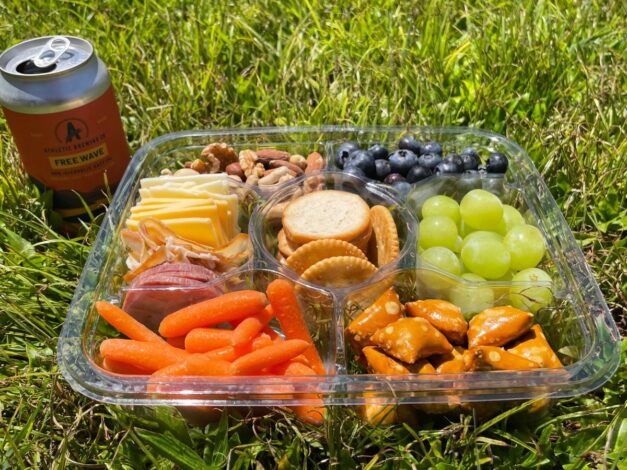
Freeze it
If you’re heading out for a fun adventure on a hot day, take along some frozen treats to enjoy such as frozen grapes, frozen yogurt tubes, frozen fruit pouches, etc. Even if they thaw out before you dig in, they are sure to provide a cold, refreshing treat on a toasty summer day.
Animal Themed Foods
One of my favorite snacks as a kid was “ants on a log”. It was simply peanut butter on a celery stick with raisins on top. I thought it was the coolest thing, and my parents were sneaking in veggies without me fighting it. I now make this snack for my own boys, and my older son will pre-make a batch and stick them in a container for our trips to the trail or the park. We top them with raisins, blueberries, and even chocolate chips for a sweet treat. Another fun animal-themed snack is butterfly baggies. Simply fill a snack bag with one or two snacks, cinch the middle with a pipe cleaner, and add a googly-eyed clothespin to finish them off. Simple and fun for kiddos to enjoy and play with during a picnic. 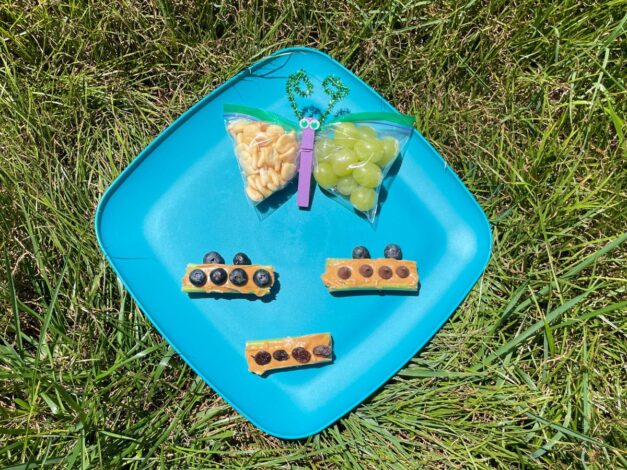
Cookie Cutters – Not Just for Cookies
You know those cookie cutters you tend to store for 11 months out of the year and pull out just for holidays? You now have an excuse to dig them out of storage and use them to make fun sandwich shapes. Our favorites are the star and evergreen tree on peanut butter and jelly sandwiches. We also use the mini-cookie cutters on fruits and veggies such as cucumber slices and watermelon. They make for a fun surprise and encourage kiddos to eat more fruits and veggies (who can resist a heart-shaped slice of cucumber?).
Food Art
Encourage your kids to “play with their food” to create fun pictures. Whether it’s cut-up fruits and vegetables, crackers, cheese sticks, etc., you may be surprised at what their creative minds come up with! Simply use a napkin or plate as a canvas, provide some examples if needed, and watch them smile and laugh. The best part? Clean-up is easy and nutritious. 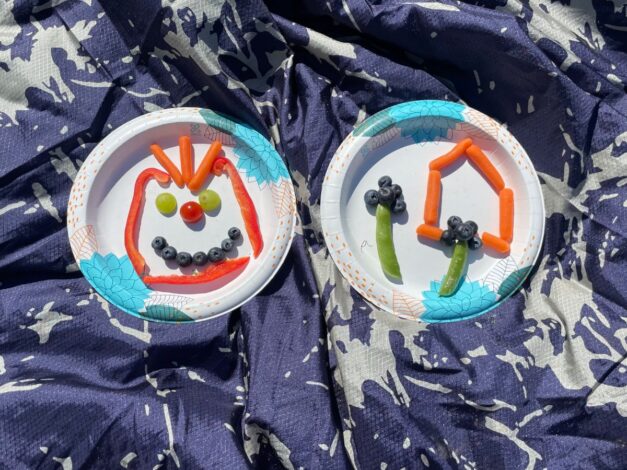
Skewer it
I remember one barbeque we attended where they provided some fun fruit and veggie skewers as an appetizer. My picky older son thought they were the coolest thing and ended up eating more fruits and veggies in one sitting than he ever had before (some of which he refused to eat when offered at home). I asked him what he loved about them, and he replied “Mom, they’re on a stick!” as if it was the most obvious answer. Ever since then, I will often bring fruit and veggie skewers on outings. I usually cut the sticks in half, pile on a pattern of fruits and veggies such as strawberries, peppers, cucumbers, and grapes, and put them in a bag to enjoy at the park.
Chase the Rainbow
My family loves “Rainbow Picnics”. We head to the fridge (or grocery store) and pick out foods from every color of the rainbow to take along with us. Once we settle down with our picnic, we create a rainbow with our food before chowing down on our colorful goodies. Here are some options we enjoy for each color:
- Red – Strawberries, red peppers, grape tomatoes, watermelon, salami
- Orange – Carrots, orange slices, orange peppers, cheese
- Yellow – Yellow peppers, pineapple, banana
- Green – Green grapes, Kiwi, Sugar snap peas, cucumber
- Blue – Blueberries
- Purple – Purple grapes, cherries, purple peppers
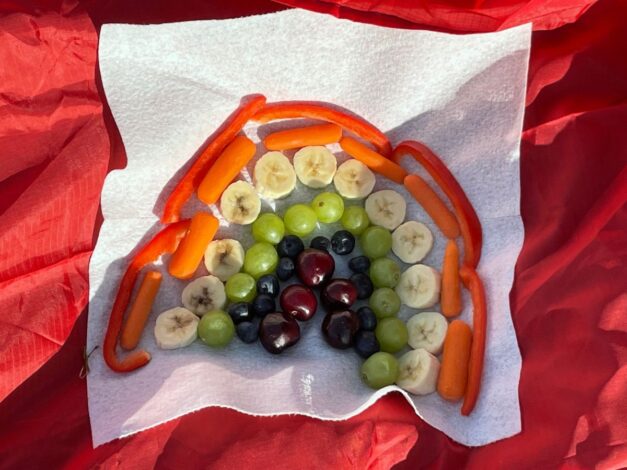
Don’t Forget the Drinks
One of my favorite things as a kid was adding fresh fruit to homemade lemonade. We would make the lemonade the night before and bring it to the park along with an assortment of fresh fruit (such as strawberries, limes, and watermelon). You could also make some decaf sun tea or even just a special bottled drink from the grocery store. Looking for an adult beverage without the side effects? I love to bring along some non-alcoholic brews to enjoy during a picnic, especially following a hike. My favorites are the Upside Dawn and Free Wave brews from Athletic Brewing Company. They’re refreshing without compromising my mental state. As a bonus, this company donates 2% of sales to protecting and restoring local trails like the ones we frequently visit.
Pick Your Own Fruit
One of my favorite things about our time in Washington State was blackberry season. We would go for a hike and snack on the blackberries growing all along the sides of the trails. Now that we are in Virginia, we have enjoyed mulberries and the occasional wild strawberry. Just be sure you know EXACTLY what the fruit is before noshing on them to prevent consuming inedible varieties. Common fruit varieties that ripen in the summer include blueberries, blackberries, and raspberries. 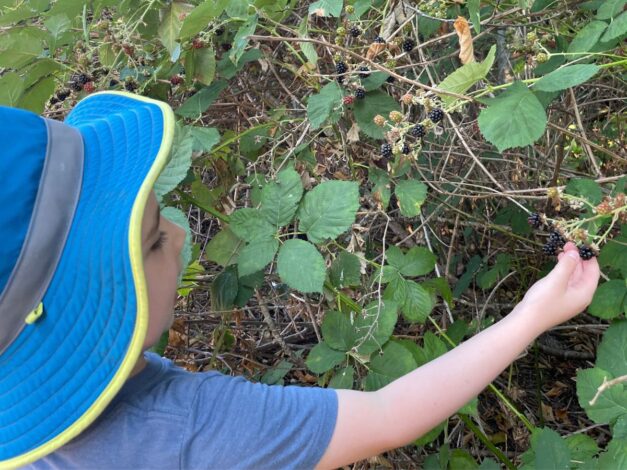
Have the Kiddos Choose
My oldest tends to be a picky eater. When we pack a picnic, I let him choose which fruit, veggie, and sandwich he brings, and we pick a special “picnic treat” at the grocery store. For older kiddos, you can have them make and/or pack the picnic cuisine themselves (with some guidelines if needed). This can add to the excitement since they get to surprise you with what they chose for the family. We want to see what goodies you bring along on your next picnic! That’s why Hike it Baby has partnered with Athletic Brewing for a #showusyoursnacks social media challenge this month.
When you are out visiting parks and enjoying your outdoor time this month, be sure to snap a photo or reel of how you and your family likes to enjoy snacks on the go! Be sure to tag @hikeitbaby @athleticbrewing #10parkchallenge #showusyoursnacks and 3 friends you think will participate in the challenge, and you will be entered to win a stocked cooler backpack from Athletic Brewing Company! (Be sure to make your settings public so we can see your posts and reels!). What playful ideas will you come up with?
ABOUT OUTGROWN
OutGrown is a 501(c)(3) nonprofit that works to create a world where everyone can enjoy the physical and mental benefits of spending time outside. We are focused on creating opportunities and removing barriers to access so families with babies and young children can take their first steps outside. We believe all families have the right to connect with nature, benefit from spending time outdoors and be inspired to a lifelong love of nature. Since its grassroots inception in 2013, OutGrown is a growing community of 280,000 families and over 300 volunteer Branch Ambassadors. More information on all of our programs can be found at WeAreOutGrown.org
EDITORS NOTE:
We hope you enjoyed reading this article from OutGrown. We’re working hard to provide our community with content and resources that inform, inspire, and entertain you.
But content is not free. It’s built on the hard work and dedication of writers, editors, and volunteers. We make an investment in developing premium content to make it easier for families with young children to connect with nature and each other. We do not ask this lightly, but if you can, please make a contribution and help us extend our reach.
Related Content





Comments